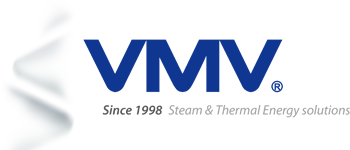A pump trap system is a device used in steam systems or other related systems to achieve efficient condensate drainage and recovery. It mainly consists of a pump-type steam trap, related connecting pipes, and control devices. Widely used in industrial production, it plays a vital role in ensuring normal system operation and improving energy efficiency.
Pump Trap System Components
Core Functional Components
Valve Body: The main body of the system, housing internal components and bearing operating pressure.
Float: Driven by changes in condensate level, it raises and lowers, controlling valve opening and closing. For example, when the water level rises to a set height, the float triggers a mechanism to switch the valve state.
Inlet and Exhaust Valves: Controlled by the float, they control the flow of operating gas (steam or compressed air). The inlet valve injects power gas, pushing condensate out; the exhaust valve releases pressure at the end of the cycle.
Inlet Check Valve: Allows condensate to flow into the valve body in one direction, preventing backflow.
Outlet Check Valve: Opens during the pressurization phase, delivering condensate to the high-pressure zone.
Level Controller: Monitors the water level within the valve body, triggering the float to achieve cyclic control.
Quick-Action Mechanism (some models): Quickly switches the inlet/exhaust valve state, improving response efficiency.
Auxiliary and Protection Components
Installed at the inlet, these components intercept impurities (such as rust and silt) in the condensate, preventing valve blockage or compromised sealing.
Bypass Pipe: Used for rapid discharge of condensate or steam during initial system operation or maintenance, preventing main valve overload.
Inspection Pipe/Drain Valve: Used to monitor drainage status and troubleshoot steam leaks.
Safety Valve: Automatically releases pressure in case of overpressure, ensuring system safety.
Lifter and Sight Glass (for Recovery Systems): Used for pump-free lifting and conveying of high-temperature condensate, and for real-time observation of flow patterns.
Expansion Joints and Flanges: Absorb thermal expansion and contraction, reducing pipe stress.
System Expansion Components (Configurable as Needed)
Automatic Condensate Pressurizer: Integrates a water tank and pressurization chamber for centralized condensate recovery from decentralized systems, suitable for long-distance transport.
Pressure/Temperature Sensor: In intelligent systems, used for real-time monitoring of operating conditions and optimization of valve regulation.
Pump Trap System Working Principle: Pump-type steam traps use steam, air, or other gases as power to transport condensate from a low-pressure area to a high-pressure area, and also from a negative-pressure area (vacuum) to a normal-pressure area. The working process consists of two stages:
Water Inlet/Steam Exhaust: Initially, the inlet check valve opens, while the outlet check valve remains closed due to high back pressure. Water begins to enter the valve, and the float is at a low position. As the water level rises, the exhaust valve opens simultaneously. When the float reaches its highest position, the controller is in a critical switching state.
Steam Inlet/Exhaust: The controller begins switching from the high position, closing the exhaust valve and opening the power steam (air) to inject steam into the valve. The steam pressure pushes the condensate in the pump towards the high-pressure area. At this time, the inlet check valve cannot enter due to high internal pressure. When the float reaches its low position, the controller switches to closing the power steam and opening the exhaust valve, entering the next operating cycle.
Pump Trap System Features
Operation Control and Stability
The system automatically controls the drainage process based on changes in condensate level, eliminating the need for frequent manual intervention and effectively ensuring system stability and reliability. It boasts strong water hammer resistance, capable of withstanding water impacts and ensuring normal operation even under complex conditions, reducing the risk of water hammer damage and extending equipment lifespan. Furthermore, it generates minimal noise during operation, minimizing disturbance to the surrounding environment and operators, making it suitable for applications with strict noise control requirements.
Performance Advantages
The absence of cavitation eliminates the damage caused by cavitation phenomena, which can lead to component damage and performance degradation. This system effectively solves this problem, ensuring long-term stable operation of the equipment. It can quickly and massively discharge condensate, meeting the needs of large-scale steam systems and ensuring timely removal of condensate, thus improving steam utilization efficiency.
Energy and Cost
Utilizing steam or air as a power source eliminates the need for an additional electricity supply, reducing operating costs and energy consumption. This makes it particularly suitable for applications with limited power supply or strict energy control requirements.
Maintenance and Adaptability
Simple maintenance, a relatively simple structure, and fewer parts facilitate repair and maintenance, reducing equipment uptime and costs. The head is adjustable; the head is determined by the pressure of the power steam (air). The head can be changed according to actual needs by adjusting the pressure of the power steam (air), adapting to different operating conditions and demonstrating strong flexibility and adaptability.
Thanks to its unique “pump-free pressurization” and “automatic steam blocking” capabilities, the pump-type steam trap plays a crucial role in many complex operating conditions. Whether in production lines requiring high-temperature condensate recovery or in special scenarios with negative pressure or explosion-proof requirements, it can efficiently and safely complete the condensate drainage task.
The VMV condensate recovery pump (pump-type steam trap) originated from foreign technology, and its original meaning is “pump-type steam trap,” also known as a mechanical power pump. It utilizes the principle of a steam trap, relying on steam, air, and other gases as power to transport condensate from a low-pressure area to a high-pressure area, or from a negative-pressure area (vacuum area) to a normal-pressure area. Please contact us if you have any needs.

